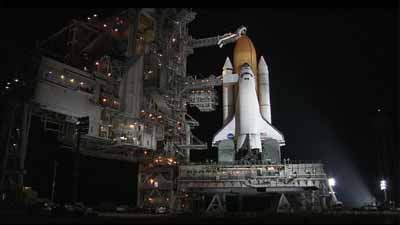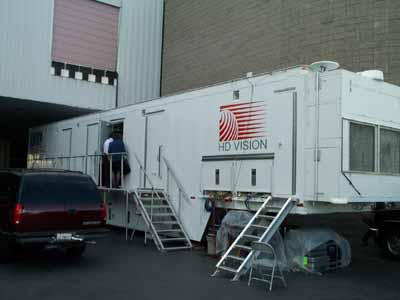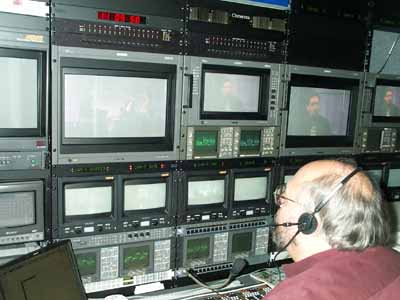Endeavoring to Shoot HD

By Claudia Kienzle for Digital Broadcasting.com
HDTV Dream Team
The Privileged View

When the NASA Space Shuttle Endeavor embarked on its 11-day Surface Radar Topography Mission (SRTM) on February 11, 2000, major Japanese broadcaster NHK took great interest in the event because Japanese astronaut Mohri Mamoru was a member of the crew.
The mission represents the first effort to create a highly accurate, detailed 3D map of (80-percent of) the Earth's land mass using radar technology. NHK carried the launch live via satellite in NTSC, and intends to produce a long-form HDTV program in the near future.
The live HDTV program, as well as the downconverted NTSC feed, was produced for NY-based NHK Enterprises America by HDTV producer Julia Mintz, co-owner of Full Res, in New York, NY, along with senior technical producer C.R. (Charles) Caillouet, owner of Vision Unlimited, in Prairieville, Louisiana. Mintz and Caillouet, both of whom have impressive HDTV credits (Mintz supervised the HDTV production of the John Glenn space shuttle launch in 1998), headed a veritable HD production dream team, starting with director Kohei Nakae and Elke Titus, acting producer, both of whom were with NHK Enterprises America.
HDTV Dream Team (Back to top)
The 30-member crew included:
- Peter Heady, the other owner of Full Res as well as HD online editor for The Tape House, New York, NY
- Abby Levine and Barry Minnerly (formerly with Rebo Studios)
- Charlie Pantuso, who designed the HDVision/WRAL HDTV mobile unit.
"The greatest technical challenge was continually revising our production plans in response to slips in the launch schedule," says Mintz. While it was initially slated for September 1999, the launch date slipped several times until the lift-off at 12:44pm on February 11, 2000. "We were perpetually maintaining contingency plans to accommodate the slip dates. In fact, putting HD equipment on stand-by (with vendors like LA-based Plus 8 Video and WRAL) became part of the production routine," said Mintz.

The HDVision/WRAL HD production truck.
That contingency was not necessary because the HDVision/WRAL truck was available. It served as the control room where 1080-line and 1035-line HD signals from five HD cameras were switched using a Snell & Wilcox production switcher. (The engineer in charge of the truck was James Lucas.) The HD production used 55,000 feet of fiber optic cable that comprises the Kennedy Space Center plant infrastructure.
"The biggest challenge to HDTV production is finding crew people familiar enough with the gear to jump in on short notice. For example, when cameramen focus HDTV cameras, they must know to go beyond the steps they take to focus NTSC cameras because proper focusing of the HD picture is so much more critical," says Charlie Pantuso, independent HDTV broadcast engineer who handled the system integration of the HDVision/WRAL truck, one of the few all-digital HDTV mobile units on the road today.

HDVision Engineer Charlie Pantuso at the controls.
"While this truck is smaller and less expensive to operate than the three HDTV mobile units offered by NMT (National Mobile Television), it does allow enough space to accommodate a director, technical director, three producers, and an audio engineer, plus a driver/grip."
The Privileged View (Back to top)
NASA also permitted placement of HD cameras at five strategic locations, including:
- Top of the Vehicle Assembly Building three miles from the launch site;
- Universal Camera Site 15 one mile from the launch site and;
- The NASA camera site 1,000 feet from the launch pad that housed an unmanned robotic head set-up.
"At the NASA camera site, we used a Sony HDC-750 camera mounted to a robotic head and remote-controlled from the truck using a Vinten autocam system," says Mintz. Manned cameras included a mix of Sony HDC-700A 1080-line HD camcorders, HDC-750 1035-line HD portables, and HDC-750A 1080-line HD cameras, with Canon 65:1 and 18:1 HD zoom lenses. Sony HDW-500 VTRs were used to record the signals in their native HD formats.
"Older 1035-line model cameras were used on the longer camera runs, over four kilometers, because the newer ‘A' model cameras did not provide usable images at those distances. This was determined during our exhaustive technical testing and run-throughs prior to the launch," said Mintz. "Also, we used special Sony camera adapters customized for this HD event by our NHK HD production team," Mintz added.
Prior to the launch, the HD camera crews videotaped B roll footage of the astronauts as they prepared for the launch and this footage will be incorporated into NHK's long-form HD presentation. On February 23, 2000, NHK also had a HD camera crew on site to cover Endeavor's return to earth. Mintz says, "We had the full support of NASA, which has been a great proponent of using HDTV to document its recent Shuttle missions."
Claudia Kienzle has been writing for the broadcast industry for over a decade. She can be reached at claudiakienzle@mindspring.com.
